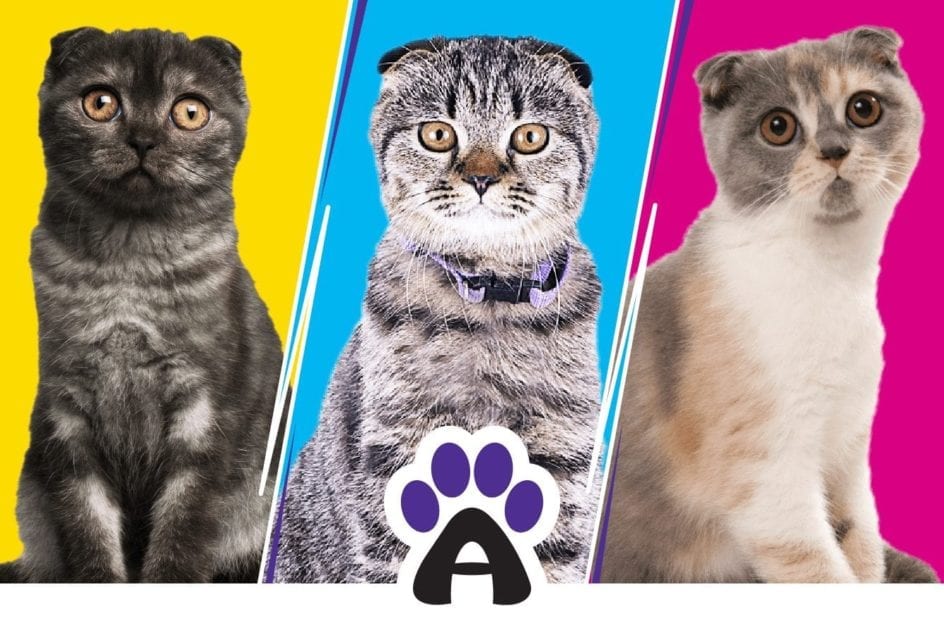The uniqueness and variety of colors of Scottish fold cats is truly amazing. Monochrome, bicolor, tortoiseshell, shaded, van, harlequin, tabby, smoky – all these are possible shades of a thoroughbred pet’s coat.
In order to not have to doubt the purebredness of the Scotsman, you need to know what shades of coat this breed has.
There are some great and Top Scottish fold Breeders In the united states that might be able to help.
Plain (solid)
Monochrome uniform coloring of Scottish cats is considered classic by breeders. The solid color of the animal assumes the absolute exclusion of any inclusions, small marks, and specks of a different color. The tone is rich, even along the entire length of the coat.
The most common were previously considered blue monochromatic Scots. But today, among the representatives of the breed, there are many other variants of solid colors.
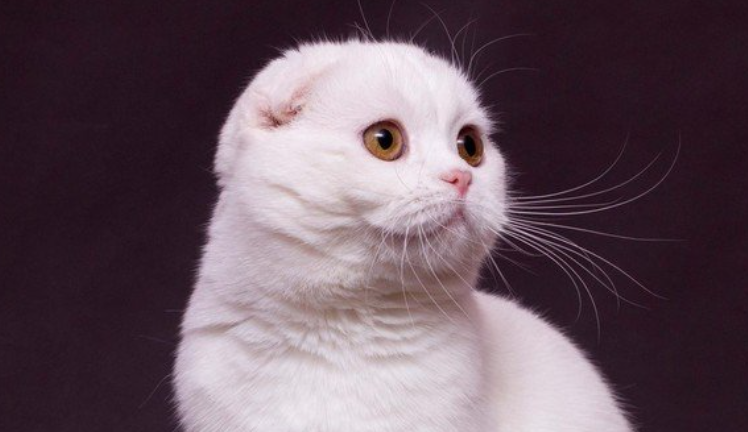
White
The Scottish fold cat with snow-white hair (without yellowness) looks luxurious. Possible eye color – blue, amber, copper. Eyes of different colors are allowed by the standard. The pads and nose are light pink.
Kittens may have markings of a different shade, which disappear after the first coat change. By the age of two, the coat of a white Scotsman should be crystal clear, with no other color spots.
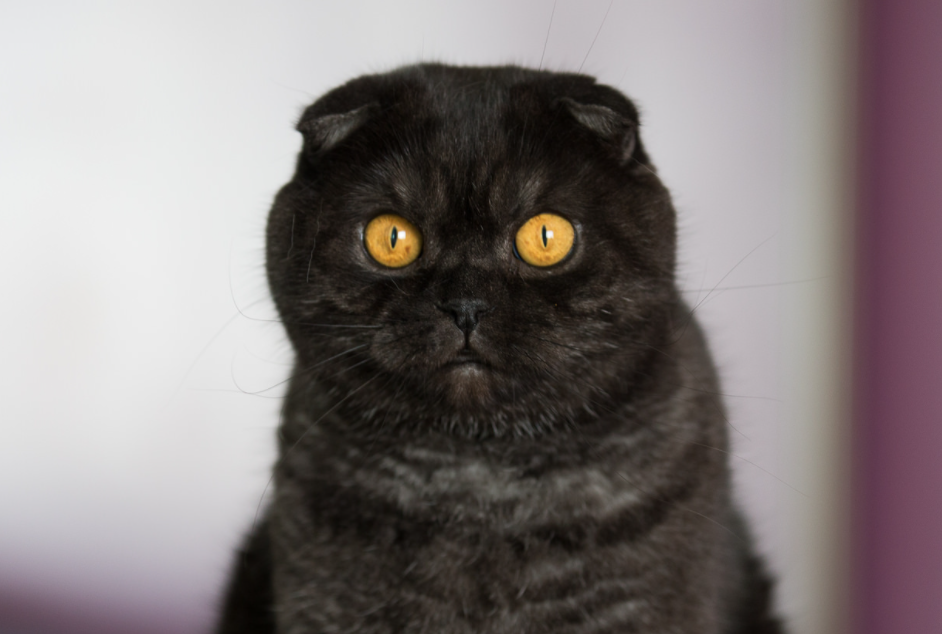
The black
The black cat has expressive yellow eyes. The nose and pads on the paws practically merge with the main color of the animal.
On the shiny bright coat of the Scottish beauty ebony, 2-3 hairs of a contrasting white color are allowed. The presence of large red or brown markings is specified by the standard.
Important: Fold Scottish pets are endowed with magical abilities. It is believed that it is the black color of the Scottish Fold that protects the house and its inhabitants from evil spirits.
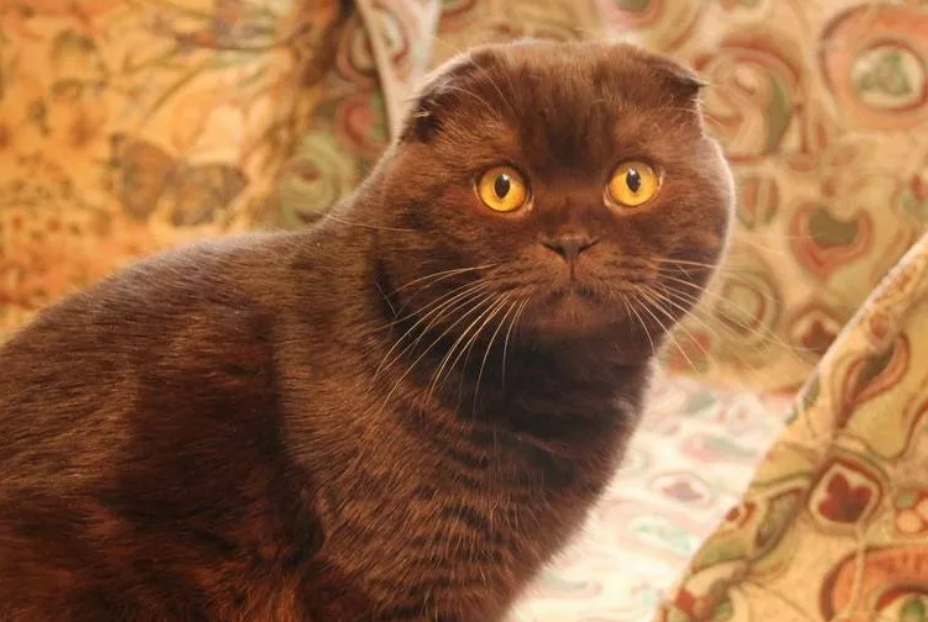
Chocolate
The brown Scottish cat, which is also called chocolate, looks noble and impressive. The color of the coat contrasts with the yellow, gold, or copper eyes of the animal. The nasal speculum and paw pads are also dark brown.
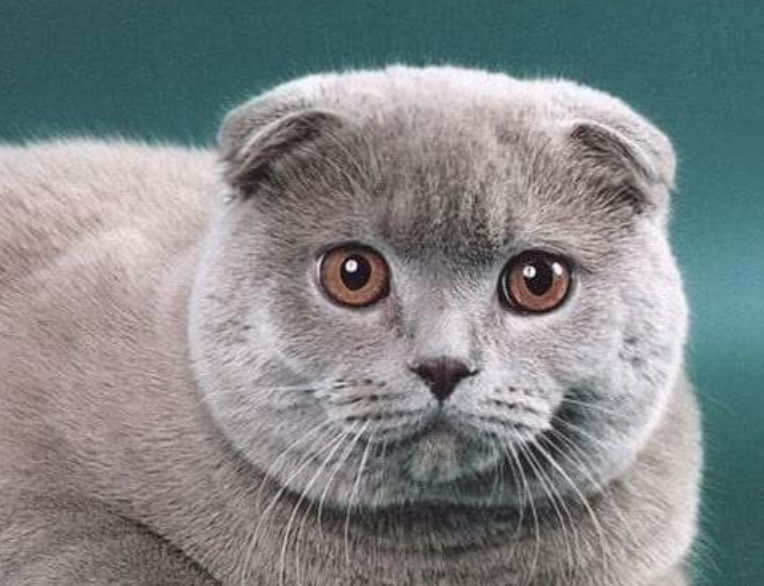
Lilac (lavender)
In a monochromatic lilac fold-eared Scotsman, a pale gray shade smoothly turns into cream. The nose is slightly brownish, the legs below are in the tone of the coat, in harmony with the main color of the pet. This lavender-lavender color goes well with copper, amber, or orange eyes.
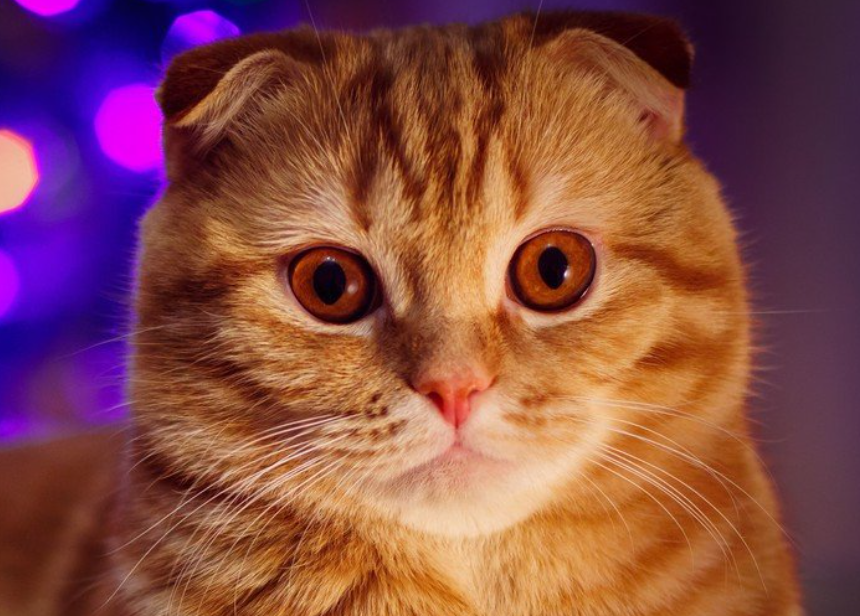
Red (Ginger)
Red or ginger is a rare and valuable Scottish color. The fiery edge is combined with the glowing amber irises of the eyes. Pads and nose to match the dominant color.
The tail of kittens and adult animals is not very uniformly colored. Such a defect does not disappear with age and is allowed by the standard. And the presence of marks on the head and limbs that remained after reaching the age of two is considered a deviation from the norm.
The red Scottish straight cat can give birth to kittens not only with erect ears but also with ears pressed to the head.
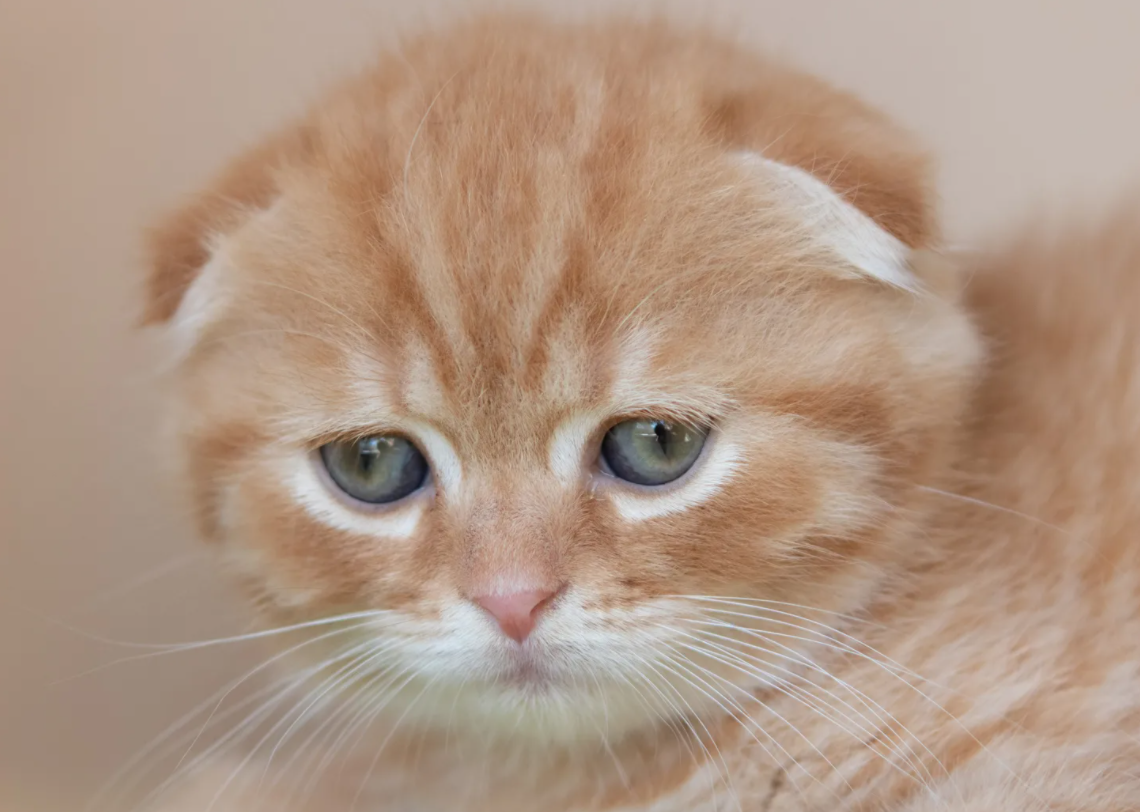
Cream
The cream or peach fold cat is infinitely elegant and handsome. The delicate background of light coat, bright golden eyes, and a pinkish nose give the pet an irresistible look. The cushions on the legs are also pink. An animal with this color bears a resemblance to the red Scotsman, but its shade of coat is one tone lighter.
A lop-eared peach kitten may have a blurry, fuzzy pattern on its paws and tail, which does not disappear with age. This is not critical for a thoroughbred pet, but leopard markings are absolutely unacceptable.
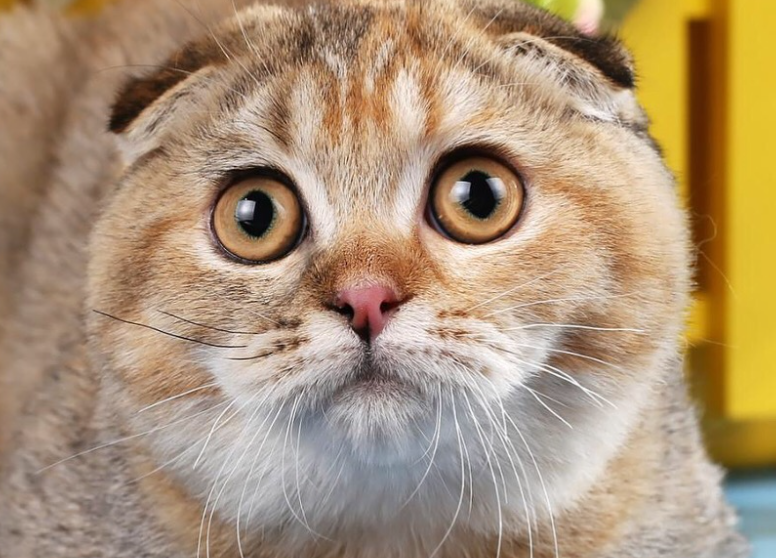
Faun (deer)
There is another unique color of Scottish Fold cats with an interesting name – fawn, which means “young deer”. The nose and pads of these cute cats are beige and pink.
Cinnamon
Cinnamon – the color is lighter and softer than chocolate, but darker than red. The nose and pads of these animals are brown, beige or pink.
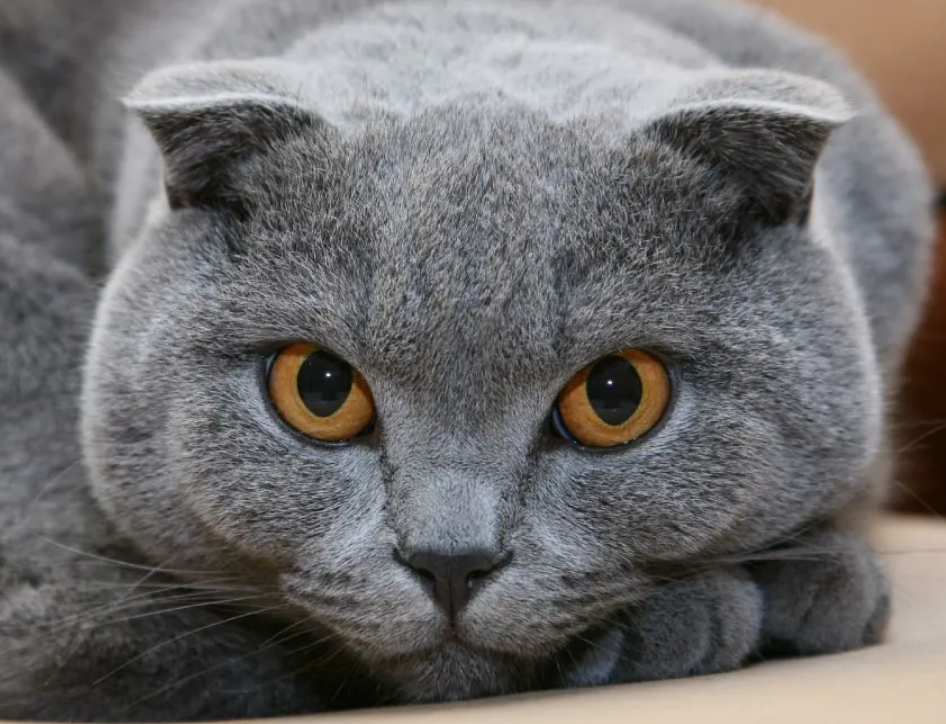
Blue color (grey)
The gray or blue Scottish cat has very beautiful amber eyes. The tone of the coat in a thoroughbred pet can belong to any range of gray – from the lightest (blue) to completely dark (blue). Moreover, each hair is saturated and well colored, without streaks.
The nose and pads practically do not differ in color from the monochromatic coat.
The gray Scottish straight-eared cat in childhood can be marked with a few divorces and drawings. But as they grow older, these flaws in color go away.
Bicolor
A peculiar color of coat is bicolor (two-tone cats). The main background is snow-white. The second color in color (cream, black, blue, red) is presented in the form of unusual patterns. Pedigree representatives should have a white abdomen, neck, chest, paws, muzzle, and beard.
A prerequisite is the predominance of a white background in color. Bicolors are more appreciated, their pattern on the body is located symmetrically. Eyes can be of any shade, but they are usually blue or golden yellow in color.
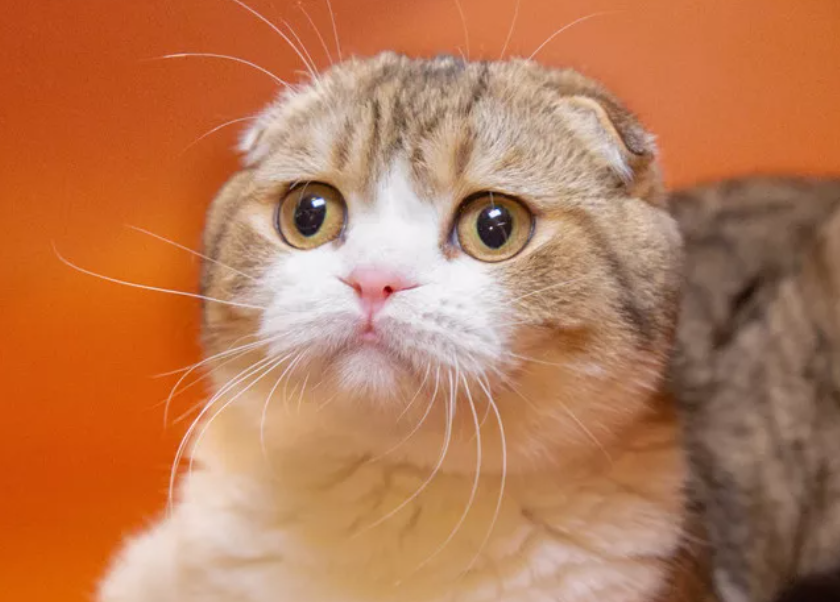
Cream bicolor
Cute cats of white color with additional stains of delicate cream tones. The eyes are blue or yellow, and the nose and pads are pink.
Blue bicolor
The pattern on the coat is blue (delicate or rich gray). The iris of the eyes is of a beautiful celestial tone or yellow-orange. The nose and legs below are pink.
Black bicolor
Black and white bicolor is characterized by deep black tone patterns. These cats have pink noses and blue or copper eyes. The symmetrical, distinct pattern on the skin transforms the cat into a true gentleman in a tailcoat.
Colorpoint
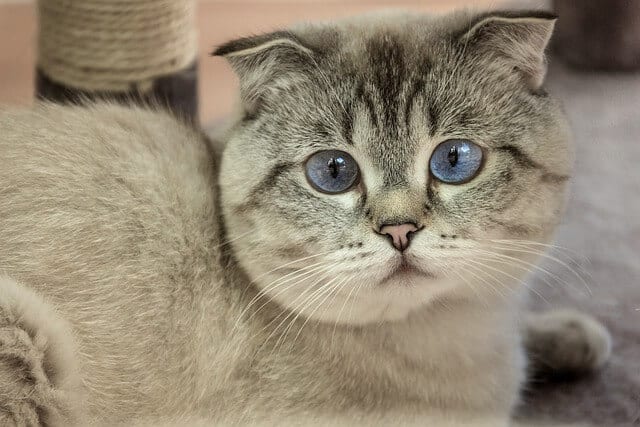
The point coloring is explained by the presence of a gene, under the influence of which, in some areas of the body with insufficient blood circulation, the coloring of the hairs increases. Characteristic darkening appears on the basic white or cream background of the coat.
The second name of the color is point links. The color of the eyes in cats of this suit is necessarily blue. Previously, this coat color was observed only in the Siamese breed. But today it is present in other species of cats, including the Scots.
Newborn kittens are completely white. Only by the age of one month, babies begin to show color on their ears, paws, tail, and muzzle. According to this color, several subspecies are distinguished among the points.
Bluepoint
This color is characterized by a pale blue-gray, an almost white shade of the body with darker, gray markings. The pale gray Scottish kittens have blue-point feet and nose that match the main color.
Cream point
The body is creamy white, and the darkening on the face and tail of the animal is in pastel cream colors. The pads and nose are pink. This point color is in harmony with the expressive blue eyes of the cat.
Lilac point
The dominant tone is pale white or lilac, and the markings are gray with a pink sheen. The nose and feet are the same as the main color.
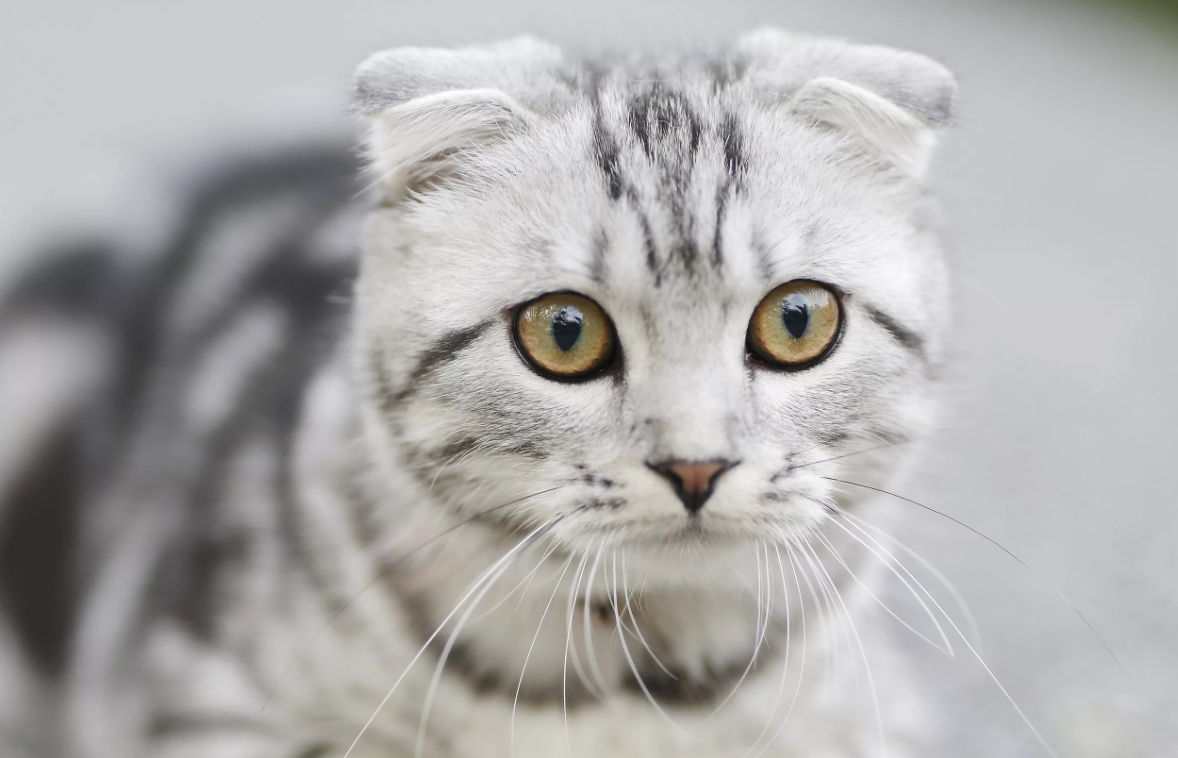
Seal point
The darkest color among the points. The dominant tone is beige. It is contrasted with brown-black markings. The same dark button on the nose and pads on the paws.
Chockleet point
Chocolate or chocklite point has a brown pattern on a creamy background. Paw pads and nose – from light cocoa to darker brown.
Redpoint
The main color of the coat is pale apricot, almost white. Darkening on certain parts of the body with a reddish-red hue. The pads and tip of the nose are bright pink.
Tortoiseshell (torti)
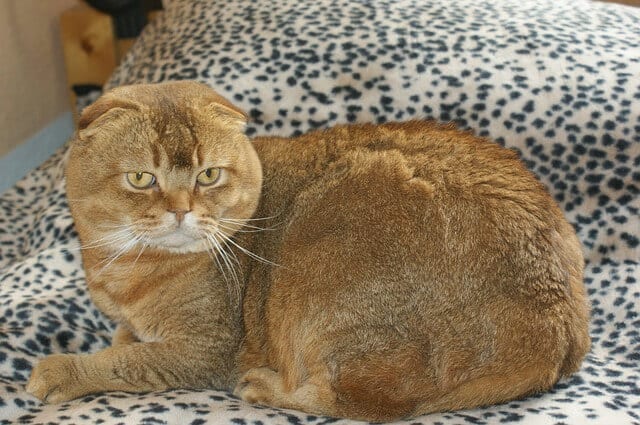
The tortoiseshell color of Scottish Folds is usually tricolor. On a cream or red dominant background, there are red, white, black spots. When the genes of the parents in a tortoiseshell kitten are combined, these marks can acquire chocolate, blue, and cream shades.
When evaluating tortoiseshell cats, felinologists pay attention to the uniform distribution of marks and the intensity of their tone. Lop-eared and straight-eared Scots with tortoiseshell color are divided into subspecies (depending on the color scale of the spots).
Black red
All over the body of the cat, there are black and red patterns. The sizes and shapes of the spots are very diverse. This color is often called cake.
Chocolate red
Patterns on the coat in brown and red shades. On a lighter background, they stand out favorably and look very interesting. The chocolate red color is considered rare and appreciated by breeders.
Blue cream
Tortoiseshell blue-cream color in Scottish pets is determined when the main gray-blue background is here and there covered with small light cream spots.
Important: tortoiseshell color is peculiar only to cats. A tricolor cat is very rare. The appearance of a tortoiseshell kitten-male speaks of genetic problems. Most likely, an adult pet will not be able to have offspring , since the reproductive functions of its body are impaired.
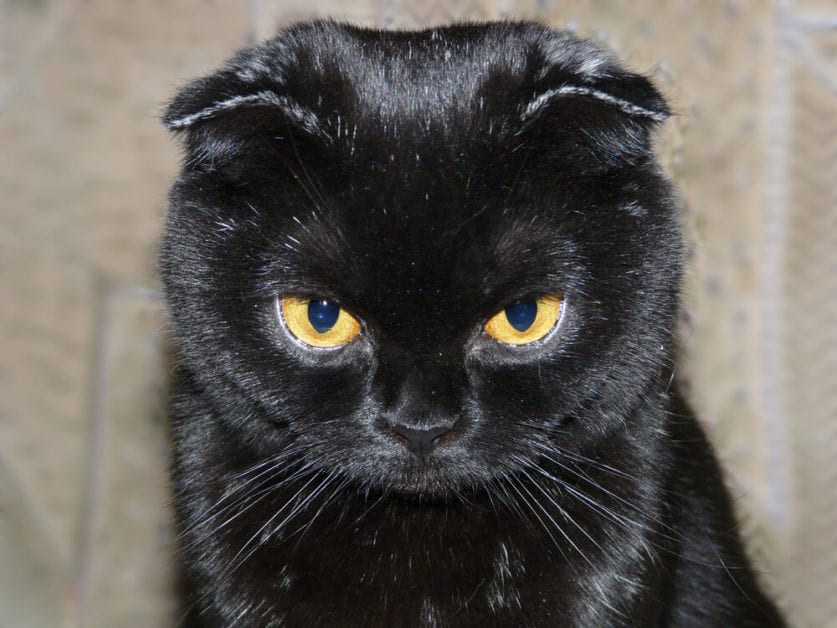
Smoky (fig)
The color of Scottish Fold cats can be smoky. Top coat of the same color, for example, black, And at the base, each hair is a silvery-white hue. This color is inherent in cats with a dominant silver gene, which creates unusual combinations of light and dark shades.
The smoky color is easy to confuse with the solid one. In order not to be mistaken, you just need to look at the undercoat. With a smoky color, the undercoat of a different shade is clearly visible, and with a solid color, the color of the roots does not differ from the tips.
The eyes of smoky cats are usually yellow-gold in color. According to the shades of smoke on the wool, several subspecies of this animal suit are distinguished.
Blue smoke
Smoky blue Scottish straights and Scottish folds are distinguished by the color of the fur coat with a gray cold bloom. But underneath the coat is white and silvery. The pads and nose of such pets are in gray-blue tones.
Black smoke
This color in Scottish cats is characterized by a black edge, but at the roots the hair is white. The nasal speculum and pads do not differ from the main background.
Chocolate smoke
The snow-white undercoat is combined with a brown chocolate top coat. The button of the nose and pads on the paws of such animals are brown.
Smoky Scottish Straights and Scottish Folds, despite the uniqueness of the color, cannot participate in exhibitions. Such cats are not recognized by the breed standard.
Tabby colors
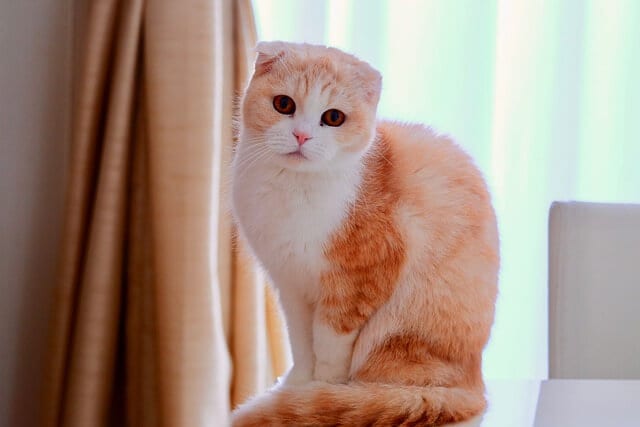
Scottish tabby cats are very popular among breed lovers. This color assumes the presence of patterns on the pet’s fur.
Depending on their shape and size, tabbies are classified into three types:
- Striped (brindle) color – the presence of clearly defined vertical stripes.
- Spotted (leopard) – the pattern is made up of spots on the animal’s fur.
- Marble – a pattern of larger, chaotic marks of various shapes.
A prerequisite for tabby cats is the presence of the letter “M” on the top of the animal’s forehead. Color combinations of wool surprise with variety:
- cream;
- golden;
- blue;
- marble on silver;
- black marble;
- silvery;
- silvery blue.
Important: The silver tabby striped Scots look like the mustachioed pet from the cat food ad . Many believe that it is the Scottish straight cat with a striped pattern that appears on the screen. This color is also called the whiskas color of the Scottish cats.

Particolor (calico scottish fold cat)
Representatives of the Scottish Particolor breed have a color in which there is a combination of white with a tortoiseshell or spotted tabby coat.

Scottish Chinchilla Cat
The Scottish chinchilla borrowed the extravagant colors of the fur coat from the British, and they, in turn, from the Persian cats. A chinchilla kitten is born only from parents with an unusual color. Each hair is colored in two colors.
Most of the light tone and 1/8 of the (top) is dark. This phenomenon is called tipping.
Tipped chinchilla colors can be of 3 types:
- Gold. The cat has a white undercoat. But on top there is a reddish-reddish bloom almost over the entire surface of the body (on the sides, back and tail of the animal). Only the beard, the ends of the ears and the belly are white. Yellow-gold eyes, pink pads and a brick-colored nose.
- Silver. White wool, tinted with silver, gives an interesting gray effect. The tail color has a hint of stripes, the nose is beige and the eyes are green. Snow-white tips of the ears, chin and belly of the pet.
- Blue golden. The rarest and therefore most valuable color of Scottish chinchillas. The undercoat is soft caramel in color, and the ends of the hair are in a luminous blue hue. Eyes – natural emeralds of rich green tone.

Scottish Fold Ticked Cat
The ticked color Scottish cats inherited from the Abyssinian breed. Each individual hair is covered with transverse dark and light stripes. One hair is colored with three colors. There is no clear pattern in the colors. The shade of the coat is uniform, usually white or golden.
Such representatives of the breed are quite rare. Kittens with ticked hair are not cheap.

Scottish fold cat Shaded (shedded) colors
An unusual definition denotes an interesting color of Scottish felines – shaded colors. In these pets, the coat is almost white, but the tip of the guard hair is colored.
The top layer of the cat’s coat can be of any shade typical of Scottish cats. The undercoat is white. The sides, back, head, tail, and ears are shaded. Light belly, chin, and lower part of the tail. There should be no pronounced spots. Allowed “M” sign on the forehead and darkish rings on the paws.
Shedded colors can be of three varieties:
- Golden. The fur of the tartan cat casts gold, the undercoat is cream or light peach. Green eyes are very expressive and beautiful. The button of the nose and the pillows on the legs are chocolate.
- Red. This type of shaded color has an auburn bloom on the coat with a snow-white undercoat. The eyes are amber, the pads and nose are pink.
- Silver. The white undercoat combined with the top dark gray layer gives an amazing gray tint. Greenish eyes are highlighted with black stripes. This feature is typical only for the silver shedded color. The rest of the species have eyes without a contour. The nose is brick-colored and the mouth is darkly contoured.
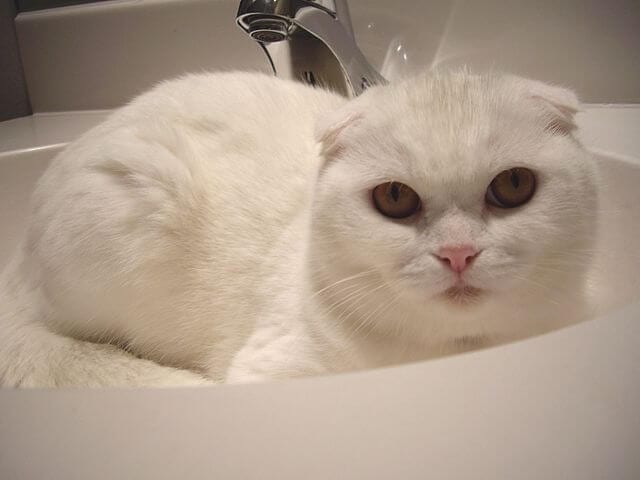
Wang
The color of the van in Scottish pets suggests a white fur coat with a dyed tail and several spots on the head. If large spots are present on the legs and back, this is considered an undesirable trait for a thoroughbred Scotsman. A cat with dark red patterns is called a red van.
The color of the spots can be monochromatic or tabby.

Harlequin
A funny definition was given to animals with an extraordinary appearance. Harlequins have a large body area (4/5) covered with white hair. But the tail must be of a different color. Also in different places, there are spots that stand out in the general tone. The paw pads and nose of the cat are pink.
Scottish cats color gene chart
To determine the color of the cat, you can use the table, which presents the international classification of animal colors. A special index, consisting of alphabetic and numerical values, gives detailed information about the following characteristics of the pet:
- XXX (three capital letters) – breed name;
- xx (two small letters) – the main color of the coloring;
- numbers from 1 to 35 – determine the nature of the coloring;
- numbers from 51 to 54 – tail length;
- digital values from 61 to 67 – eye color;
- additional numbers from 71 to 73 – the shape of the ears.
The color code is as follows – XXX.xx.NN.NN.NN. (NN)
For Scottish thoroughbreds, the following abbreviations are used:
- SFS – Scottish Fold (shorthaired fold);
- SFL – Highland Fold (Long-haired Fold);
- SFS 71 – Scottish Straight (Straight Shorthaired);
- SFL 71 – Highland Straight (Longhaired Straight).
Further in the code are encrypted letters and numbers.
| Designations | Decoding |
|---|---|
| Main color | |
| a | blue |
| b | chocolate, brown, havana, champagne |
| c | lilac, lavender, platinum |
| d | red |
| e | cream |
| f | tortoiseshell |
| g | blue cream, blue tortoiseshell |
| h | chocolate tortoiseshell |
| j | purple tortie |
| n | black, ebony, seal, sable, wild |
| o | sorrel, cinnamon, honey |
| p | yellow-brown, beige |
| q | red-brown tortoiseshell |
| r | beige tortoiseshell |
| s | silver, smoky |
| w | white |
| x | unregistered color |
| y | golden |
| The nature of the colors | |
| one | van |
| 2 | harlequin |
| 3 | bicolor, two-tone |
| four | with white markings for color points |
| nine | white spot (.39-0.78 inches) |
| eleven | shaded – 1/4 of the top of the hair is shaded |
| 12 | veiled – 1/8 of the top of the hair is darkened |
| 21 | striping, agouti factor |
| 22 | marble |
| 23 | mackerel, brindle |
| 24 | spotted |
| 25 | tekirovanny or abyssinian |
| 31 | burmese |
| 32 | tonkin |
| 33 | himalayan, siamese, point |
| 34 | Singaporean |
| 35 | Abyssinian |
| tail length | |
| 51 | tailless pet |
| 52 | for bobtails and menx 1-2 vertebrae – the remainder of the tail |
| 53 | 3-5 inches coiled tail (bob tail) |
| 54 | normal/long tail for manks |
| Eye color | |
| 61 | blue |
| 62 | yellow, orange, golden |
| 63 | disagreement |
| 64 | green |
| 65 | Burmese eye color |
| 66 | the eye color of Tonkin cats |
| 67 | the eye color of Himalayan and Siamese cats |
| Ear shape | |
| 71 | straight ears |
| 72 | twisted back |
| 73 | spun forward |
Lop-eared and straight-eared cats with long and short hair can have any color – there are more than 50 color options. And if you add to this a cute little face and a naive look of a Scottish kitten – emotions just go wild.
It is impossible to pass by such a mustachioed fluffy miracle. But it should be remembered: no matter what color the chosen pet is, it requires care, care, attention, and love.

